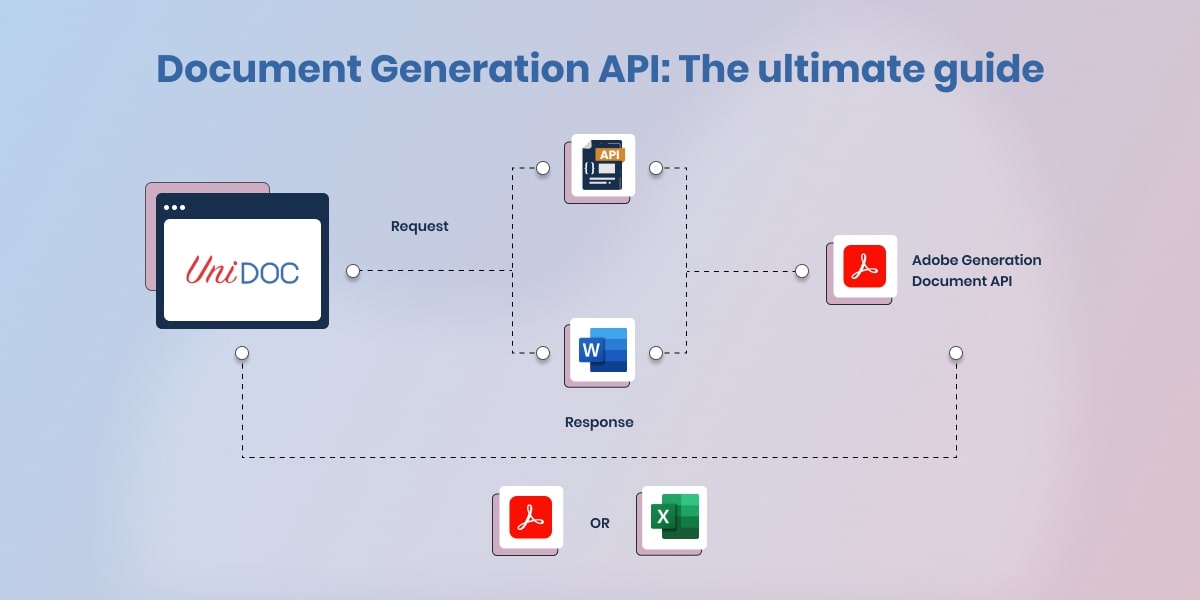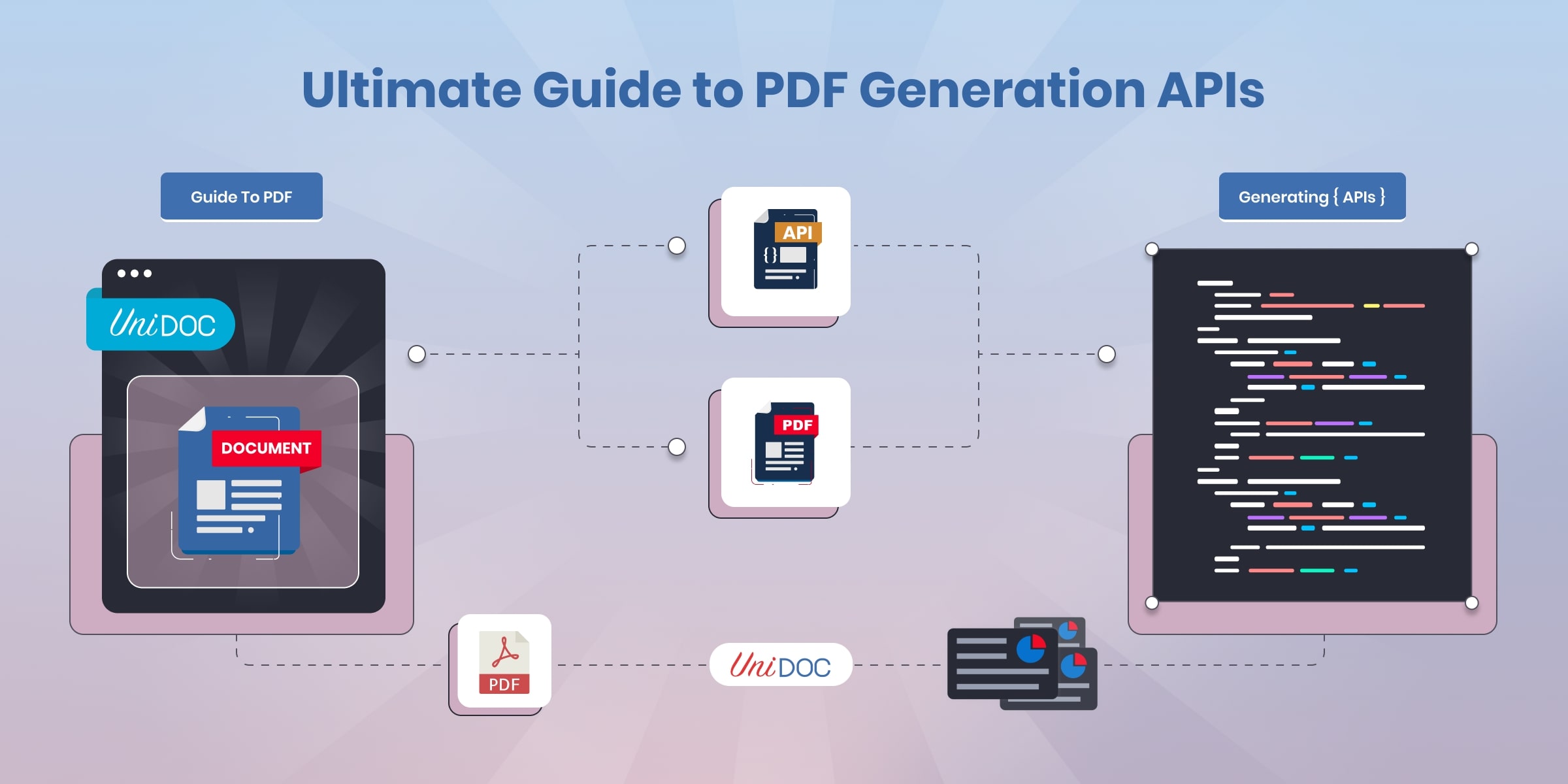Document Generation API: A Comprehensive Guide with UniDoc

Document Generation API has become invaluable tools in today’s digital environment, automating document production based on dynamic data. Their importance lies in their ability to increase productivity, guarantee accuracy, and maintain consistency across various business processes.
These APIs serve as the link between raw data and formatted documents, enabling software applications to generate reports, create invoices, contracts, and other types of documents without human intervention. Document generation APIs can be especially valuable to industries such as finance, healthcare, legal services and other industries, which require extensive personalized documentation.
By automating document workflows and eliminating manual errors, and by conserving time and resources with predefined templates and rules that ensure generated documents meet specific standards, document generation APIs offer significant productivity gains, streamlining the documentation needs of these industries.
Let’s have a deep dive into the document generation API guide.
What is an API?

When you access a weather app on your mobile device, it seamlessly interacts with this system through APIs, enabling you to receive up-to-date weather information directly on your phone.
In essence, APIs act as the intermediaries that enable seamless integration and communication between disparate software systems, ultimately enhancing user experiences and functionality across various platforms.
The difference between REST API and API related to benefits.
REST API, which is a Representational State Transfer Application Programming Interface, follows a unique set of principles and constraints to facilitate the practices production of mutual communication, both scalable and stateless. All REST APIs are there are not all APIs are they have to be of REST nature.
The differences in architectural design were the first to bring a clear line between both. Because traditional APIs can be developed by means of several protocols and data structures, the REST APIs only follow principles, such as statelessness and client-server architecture along with uniform interface indeed make them more flexible and scalable in some cases.
From looking at it as a whole, all REST APIs are APIs but the reverse is not true. In generic terms, APIs range from several architectural and stylistic variations, while REST wraps itself with some distinct principles to give its structure behavior.
What is API Documentation?

It serves as a reference, which describes in detail the API’s feature set, endpoints, request and response structures (the different possible input formats for sending requests to the API or OAuth2 token URLs, accepted formats of returning results), authentication approaches used etc.
Excellent API documentation serves to significantly diminish the cogency learning time, empowering developers to instantly get how to interface with an API and consolidate it into their advancement ventures.
It is mainly constituted by code samples, sample requests and responses for the API, the details concerning error handling as well as any provided specs necessary for proper working of the API.
Detail the fundamental concepts.
Document Generation:

How Document Generation APIs Work?

Use Cases and Applications
Automated Report Generation: Businesses requiring regular sales, financial, or analytical reports will benefit from using automated report generation to automate this task.
Invoicing and Billing: Generating customized invoices based on transactional data.
Contract Creation: Auto-generating personalized contracts or agreements using client data.
Custom Communications: Generating personalized letters, emails, or notifications specifically for individuals.
Technical Overview
Detail for Document Generation API.
Architecture typically comprises three primary components.
Data Source: The origin of data, which could include databases, CRM systems, user input or any structured repository of structured information.
Template Engine: An administrative system which holds various document templates defining its structure and design for final document production.
Document Engine: The core component which merges data with templates to create final documents.
Key Components and Their Functions
API Endpoint: An interface through which requests can be sent and responses received.
Data Processing Module: Responsible for extracting and formatting of data from its source, while Template Manager stores and retrieves document templates.
Rendering Engine: Produces final documents combining both data and template into final formatted documents in accordance with desired formats.
Implementation Guide Detail:
Step-by-Step Implementation Process.
Integration Prep: Understand the API requirements, prepare data sources and templates accordingly, and configure API Endpoints with authentication credentials as required to generate documents. Anschliessend, it’s necessary to configure parameters necessary for document generation before setting up API endpoints with authentication credentials for document generation.
Template Design and Upload: Construct document templates using your chosen document management library or software before uploading them to the template engine, making sure they are formatted and tagged accordingly.
Data Mapping and Testing: Arrange your data fields against placeholders within your templates before conducting test runs to verify accuracy.
Implementation: Integrate API calls into application workflows where document generation is needed.
Best practices for Integration:
Template Adaptability: When designing templates that can easily accommodate changes to document structure or content.
Data Security: Choose an API with robust security features to safeguard any sensitive information during document generation.
Scalability: Look for one that can expand as your document generation needs grow without impacting performance negatively.
Error Handling: Implement robust error handling measures to address any potential issues during document creation with grace and professionalism.
Conclusion:
Document Generation APIs represent a powerful combination of innovation and efficiency in the digital era, offering businesses a powerful tool to automate and enhance document-related processes.
As technology progresses, these APIs will become even more integral to business operations as they drive toward agility, customization, and efficiency in future-proofing businesses in a rapidly advancing digital landscape.
Embracing Document Generation APIs is more than an operational upgrade; it’s an investment towards future-proofing business operations in an ever-evolving digital environment.
Boost your paperwork process with our document generation library! Try our 14-day free trial and see the difference. Questions? Our team is here to help. Reach out anytime!


